I am extremely grateful to Jim Knight for some of the information and photos in this article
Lionel Crabb was born in 1909 to Hugh and Beatrice Crabb who lived at the time in South London.(he later got the nickname ‘Buster’ in honour of the American swimmer, turned actor, Buster Crabbe) They were a poor family and Crabb’s father Hugh was listed as Missing during the Great War. For most of Crabb’s early days he was brought up by Frank Jarvis, a relative of Beatrice who came to stay after the War. For a short and unhappy time Lionel went to school at Brighton College but then transferred to H.M.S.Conway, a Naval Academy. When he left school he was a bit of a drifter having lots of different jobs, and not much liking any of them. In the end Crabb tried to join the Navy in 1939 when he was twenty eight. He was refused on medical grounds, was to old to join the Reserves, so he joined the Merchant Navy instead.
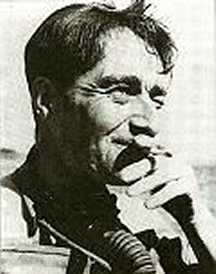
When the Second World War started up he trained as a Merchant Seaman Gunner, and because of this he was able to join the Royal Navy Patrol Service that used trawlers to clear mines. At last he was where he wanted to be. Unfortunately he had to have a medical at some stage, and when he did, it was found that he had a weak left eye, and so he was banned from further sea service. Fed up, Crabb volunteered for Special Duties, and ended up becoming a mine and bomb disposal expert. He was sent to Gibraltar in 1942 to work with the Mediterranean Fleet Clearance Diving Team. His job was to make safe the mines and warheads that the divers discovered. After doing this for a while he thought he could be of more use if he became a diver, and applied to join the Team. Crabb hated the idea of any sort of fitness training, smoke and drank heavily and could only just swim three lengths of a swimming pool, but the head of the Diving team Lieutenant Bailey, accepted him because he was good at mine disposal. (incidentally, when I did my Ships Diver training in 1967, there was no requirement for you to be able to swim)

In those days diving equipment was very rudimentary, as up to the outbreak of the Second World War the Navy did not consider the Diver to have an offensive role, and used them mostly for clearance diving or repairing ships bottoms. However attacks by the Italians using Midget Submarines during the First World War put soon paid to this idea. By the time the Second World War started the Italians had become much more sophisticated, and by 1941 had damaged two battleships, H.M.S. Queen Elizabeth and H.M.S. Valiant in the port of Alexandria. By the time Italy surrendered, their midget submarines had sunk 190,000 tons of merchant shipping, and over 90,000 tons of Allied warships. Bailey and Crabb built up the Underwater Working Party, and when Bailey broke his ankle, Crabb took it over. Crabb had to constantly adapt to the Italian threat especially when the Italian’s started to use human torpedoes. The unit secretly took up residence in an old battered steamer called the Olterra moored in a neutral Spanish port just five miles from Gibraltar.
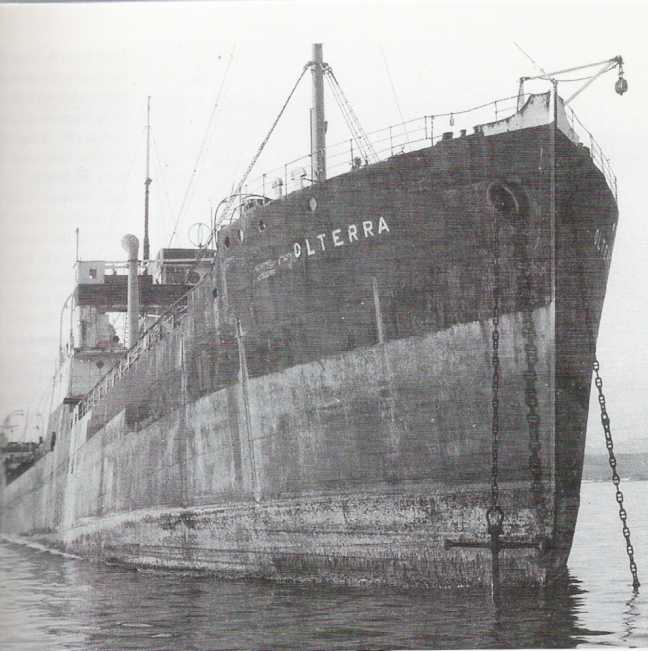
On board the Olterra the Italians made a workshop to equip their subs and cut an entrance hole below the waterline so that the human torpedo’s could be launched in complete secrecy. On the 7th December three of these were launched to attack shipping in Gibraltar Harbour, and it was only because of Crabb’s vigilance along with his assistant Leading Seaman Bell, that all the attacks were foiled. Just imagine it. With no proper equipment, no suits, just overalls, no fins, just plimsolls, and to breathe a Davis Submersible Escape Apparatus, the two of them patrolled in the dark searching ships bottoms never knowing if a mine was about to go off.
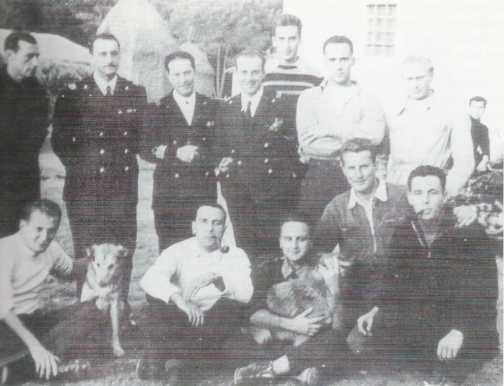
Ironically the Italians surrendered the next year and Crabb was able to not only visit the Olterra to recover various bits of submarines, but he also visited the Italians who had used them. They apparently had a great respect for Crabb and were happy to assist him in his quest to develop these weapons. For all this work and much more, Crabb was awarded the George Medal, and promoted to Lieutenant Commander. Interestingly leading Seaman Bell also got the George Medal and was promoted to Petty officer. This was a bit unusual as it was usually Officers that got the gongs, with the men getting a bit of praise.
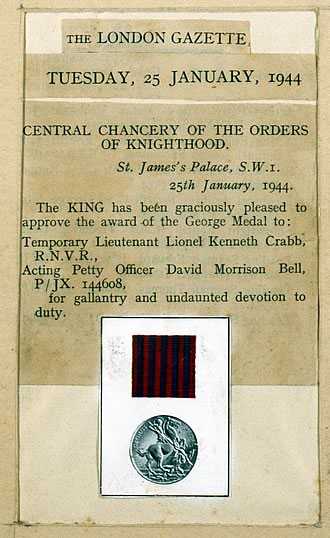
Crabb was then sent to Venice to clear the harbour of wrecks, and when that was finished he was awarded the O.B.E. In 1945 he was moved to Palestine to head up an underwater bomb disposal team and was demobilised in 1947.
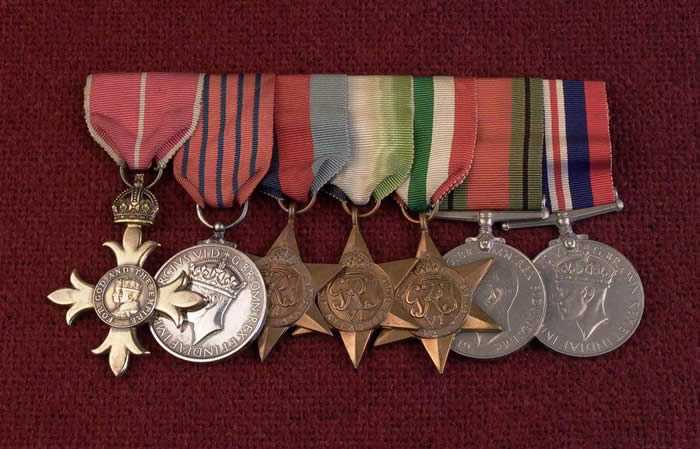
Some say that he was then recruited into one of the Secret Services. It is a fact that he was recalled to help with the affair of the sunken submarine Truculent that sank with all hands in the Thames Estuary, and in 1956 he was listed in the Navy List as Commander Crabb, Special Branch, based at H.M.S.Vernon in Portsmouth. In 1953 he was supposed to have been in the Suez Canal, and a year later was unsuccessfully engaged to look for the Tobermory Galleon. In October 1955 Crabb was apparently instructed by the Royal Navy to find out why the Russian Cruiser Sverdlov was so manoeuvrable. The ship was in Portsmouth as part of a Spithead Review and since the Americans were also very keen to find out, the mission was overseen by them. Crabb swam to the bottom of the ship where he found a large hole from which a propeller could be lowered to provide more thrust for the bow, which explained the Cruisers superb manoeuvrability. It was the success of this mission that seemed to spur on the idea of inspecting the bottom of the Cruiser Ordzhonikidze which was due in Portsmouth in April 1956 carrying the Russian President Kruschev and his Foreign Minister, Bulganin on a good will visit.

By now Crabb was 46 years old, unfit and a very heavy drinker. On the night of 17th April 1956 he an another un-named man took rooms in the Sally Port Hotel. The next day the Russian ships arrived and tied up at the Suoth Railway Jetty in the Dockyard. That night Crabb was seen in Havant having a drink with some old friends and then he caught the train back to Portsmouth. He was never seen alive again. Less than two months later a body in a diving suit was found floating off Pilsey Island in Chichester Harbour. The body was minus its head and hands thus making identification very difficult. Crabb’s ex wife and his current girl friend, Pat Rose could not say with any confidence that the body was Crabbs. However an inquest recorded an open verdict and the Coroner said that he was satisfied that the body was that of Commander Lionel Crabb.
Recent information (March 2010) has led me to believe that I was wrong about the body being recovered two months after the event. At the time, Jim Knight was a member of an R.A.F. Marine Craft Unit stationed at Portsmouth and has given me the following information which casts a different light on subsequent events.

Cmdr. Crabb’s body was not found 2 months after his disappearance. It was 14 months from the 19 April, 1956 to 9 June, 1957.The Body was not found ‘floating around’ in Chichester Harbour. It was in fact brought to the surface by 2 net fishermen, from Prinstead or Southbourne, West Sussex. They made some sort of SOS signal that was seen by the lads in the Air traffic control tower at RAF Thorney Island. ATC in turn notified us at the Marine Craft Section in the mid morning. Myself and two other members of 1107 MCU detachment were duty week end crew. We had an old World War Two 40 ft assault landing craft which was used for inshore and harbour rescue, and in this craft we made our way to Pilsey Island which was only about a mile up channel towards the Solent. We found the fishermen with their net tangled up, with what eventually turned out to be Cmdr Crabb’s body.Untangling the net, we hitched the body onto the lowered front ramp and got it on board. You are correct in that the head and hands where missing, and in the cavity where the head had been, were hundreds of small crabs, and other such creatures. The odour was abominable.On returning to the MCS (Marine craft Section) we were able to run almost up to West Thorney road, due it being still high tide. Waiting for us on the bitumen, were a mob of RAF Officers, 4 men in long black overcoats, RAF Ambulance, local Police and many unknown onlookers.The body, still clad in a frogman’s suit was removed to Chichester Hospital for examination and identification.Later, we members of the Marine Section discussed the incident. None of us could see how the body was indentified. With the advent of DNA, perhaps it could now be proven one way or the other, if the body was that of Cmdr Crabb. Among those on the beach that day was Group Capt. Boxer, Station Commander of RAF Thorney Island. The 4 men in black overcoats must have been MI 6 or such.I have checked the RAF records at RAF Hendon, and they told me that all the records for ALC 1948 had been destroyed. It is a pity that no one has ever given credit for the recovery of the Frogman’s body to the RAF Marine Craft Section.
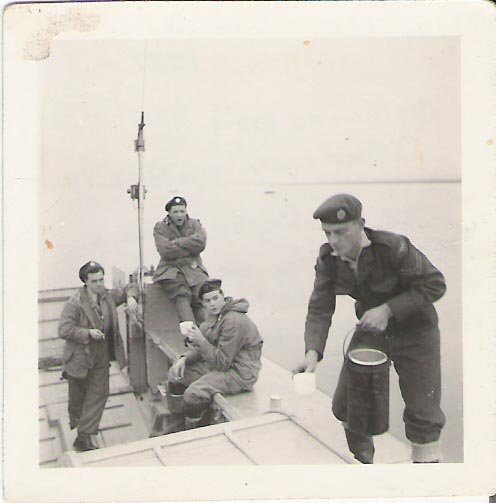
In every report I have read on this incident, there is no mention of our (Marine Craft) involvement in this clandestine affair, much of which is still under wraps. We ourselves, following the dispersal of the official’s, were reminded of the ‘Official Secrets Act’ and told to keep our mouths shut. On my enquiry to the RAF Museums Historical Section for details of the Daily running record (RAF Form 1524) for ALC 1948, for the date of 9/7/57, I was informed the records for many Marine Craft had been destroyed or lost. Was that not convenient. I have contacted some of my ex crew mates some of which have passed on. Only one remembers the incident,but was not involved. I have been trying to get information of this for a number of years now. Just to prove that I did not dream the whole thing.Another coincidence is, that just a few day prior to Crabb’s disappearance, myself and a few apprentice mates (Shipwright’s in PortsmouthDockyard) went to have a look at the Russian ships, unaware that I would be involved with Cmdr. Crabbe’s espionage attempt again in 14 months, but this time as a National serviceman on RAF Marine Craft.
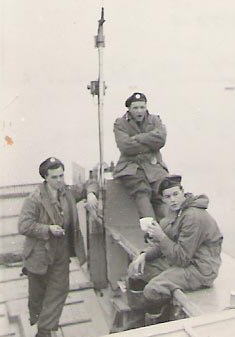
In the photo above, you can see the front ramp door behind my back. This we dropped to water level to secure the frogman’s body, then raised slightly, to prevent sinking ourselves. Only one other member of this crew was involved in the recovery. That is the chap sitting on the side holding his cup of tea. L.A.C Ray Howes. (I believe he lived somewhere near Hornsea, S/E Yorkshire) I am standing next to the cockpit, with my back to the ramp door. The aerial was for the “PYE” phone VHF Radio. It was a short distance radio which we were able to contact Thorney Island Air Traffic Control.
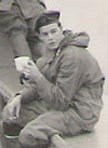
MI6 and the Admiralty tried to cover the story up and made a complete hash of it. The day after Crabb disappeared all his belongings also disappeared from the hotel, as well as the relevant page in the hotel’s register. The press had a field day, and the incident sparked off a major diplomatic row with the Russians who accused the British of a bungled attempt to spy on their vessel. The then Prime Minister, Anthony Eden was furious when he found out what MI6 and the Admiralty had done, as he had expressly forbidden any such operation. A security blanket was thrown over the whole thing, and even today the major facts of the case have been reclassified so as not to let them into the public domain until at least 2050. Sir John Sinclair head of MI6 was forced to take early retirement and some other senior civil servants were severely censured.

So what really happened? Well you can take your pick There have been about ten books written on the subject, and acres of newsprint. In some he was captured by the Russians and brainwashed. In others he defected, and of course the Navy said he wasn’t there at all. However its fairly certain that Crabb did swim out to the Russian vessel. But what happened next is down to who you believe. The most credible evidence seems to be a Joseph Zwerkin who was an ex member of the Soviet Naval Intelligence. He was interviewed in Israel in 1990 where he had moved after the fall of Communism. He stated that a diver had surfaced near the ship and had been shot in the head by one of the ships crew. Seem’s about right to me. All the secrecy surrounding this affair seems to be not so much about Crabb and what he did, but rather about what the various Government Agencies did, why they did it, and why did they cover it all up. It is interesting to find out that the Official Government Documents relating to this affair are not scheduled to be released until 2057.
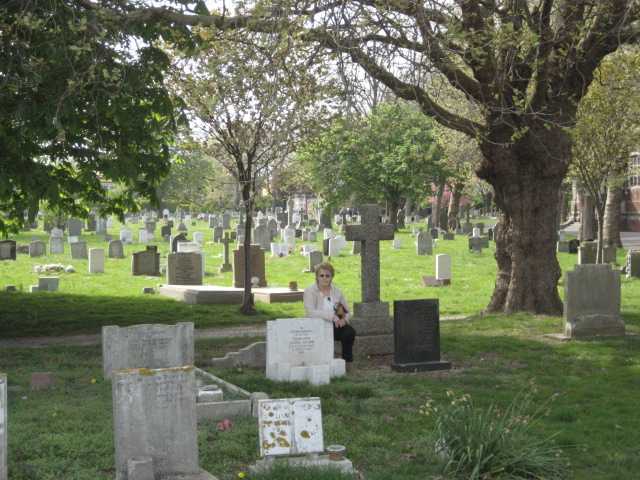
I decided to put this story in the Tombstone section because Crabb was a bit of a hero to me. I come from a generation of divers that remember him as one of the ‘greats’ In the same way that a Copper would stop you for speeding in the old days before camera’s, and say the immortal lines, ‘who do you think you are Stirling Moss’, we in the Service would be told off for doing something daft in the diving area with the line ‘who do you think you are, Buster Crabb’. If you want to get a flavour of the man have a look at the film The Silent Enemy which depicts his time in Gibraltar. Not a bad epitaph.
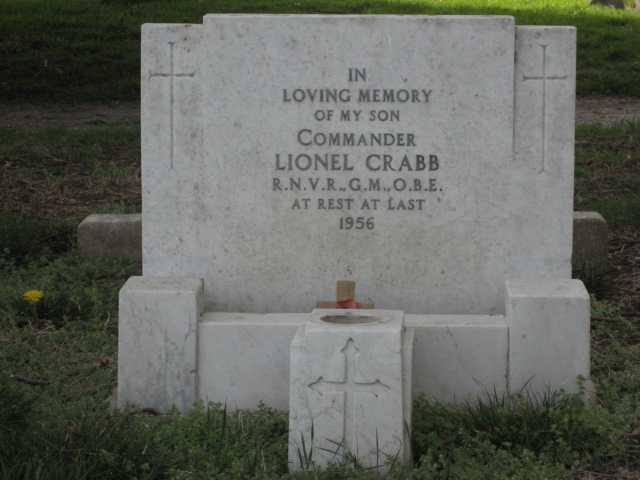
‘Busters grave can be visited at Milton Cemetery, Milton Road, Portsmouth.


Michael Peachman says
Rest in peace uncle, my mother and uncle Percy surface fleet, uncle Jack submarines used to tell me about you since I was about 5 years old.you make me feel proud to be from an RN family.
christina millard says
I would like to thank you for this most interesting article. I was recently discussing with a relative the disappearance of my Uncle Eric. This relative was the last person to see him ou tof the family. Evidently at some stage Eric who had beena professional Marine joining before the war and stayed in for a time after,had given the relative a set of flippers( quite a rarity in those days,as he was driving Some people about who were involved in SAcuba and Buster Crabb’s name was in there somewhere. I ,a few years ago decided to try to trace my uncle as I’d never known him.All the family had said that he was a bit of a rogue.He had two sons who I wanted to get in touch wi8th. At one stage,I understand they were in an orphanage. Anyway a few years ago, I contacted the Red Cross. I received two letters. The first telling me that the Appropriate body had been informed! I took this to mean that he was alive (though by now I doubt it as he’d be around 90) The second reply was very clearly a “back off!” I would so like to find out if he was involved,as I thought it seemed as though maybe he’d had to go under a protection plan or something. His name is Eric Boxall. If you have any thing that could enlighten me I would appreciate it. Many thanks Christina Millard nee Gibbs/Boxall
Jeff says
Very interesting. I have Cmdr Crabb at HMS Vulcano in Cumberland some time during WW2. Was he an Insructor there.
Thanks
Jeff
g.russell says
i saw buster crab on stage in a water tank doing a limpetmi
ne attack on a suppossed ship side in the late forties in the golders green hippodrome/theatre my mom took me to see him thats why i think i joined the rn and amongst other things became a diver
Tim Baber says
I tipped off a contemporary dive magazine of a snippet that a fisherman at Avon beach/Highcliffe had found in the sea a body without limbs and or head wrapped in bandages soon after the Crabb affair. He notified the police and the body was removed and I forget what else now. This I think only emerged in a national newspaper a few years ago, and it was on my msbnes patch, but apart from passing the baton I was put off by all the research it would need to be authoritative, so I let it ( the “story”) slip. Tim Baber 01425 461360
Carey Mackinnon says
If its of any interest I witnessed the entire recovery of the body off Pilsey Sands in 1957. We were moored at East Head.
Submerged Comment says
Harry Forster (h.l.forster@btinternet.com) wrote:
I was a Leading hand on board H M S Scarborough and immediatley tied up forward of the Cruiser Ordzhonzkidze on18th April 1956? we some visitors from that Cruisers came on board us,was not privy to who they were,but a lot of security,photos of that CRUISER. UNFORTUNATLY MISPLACED
I was also involved when the submarine H M S Sidon sank in Portland harbour in 38 feet of water
A Mistake made by the wine officer off the H M S Maidstone,who stood in. For the duty officer who. Was adrift (late)
Submerged Comment says
Charlie Osborne (osborne197@talktalk.net) wrote:
I have only a small snippet of information. My girl friend at the time, ( Margaret Johnson, 1950/51 ), worked at UCWE in Havant . Underwater and Counterweapons Establishment. She accompanied Crabbe in his car several times and told me at the time what a strange,extrovert man he was, and I think she said he always carried a swagger stick. They went to London and of course to Portsmouth. Margaret became my wife in 1954 , she died in 1998 aged 67.
John Bevan says
Great website! Thanks. We have an exhibit at the Diving Museum dedicated to Cmdr Crabb and Sydney Knowles. It includes Knowles’s medals, diving knife, red wooly hat and two of his original paintings. The exhibit is temporarily loaned to the Discovery Centre in Gosport over the winter. We also have a two-hour DVD interview of Sydney Knowles (also for sale) as well as copies of his book.
John Bevan says
Could Carrey Mackinnon please contact me? I’m interested. Thanks. My email:
johnbevan@submex.co.uk
Joseph McCormick says
I would like to point out that there were two members of the bomb and mine disposal unit at Gibraltar named Bell. One was leading seaman Bell and the other was Petty Officer David Morrison Bell. It was he who was awarded the George Medal at which time he was Acting Petty Officer.
Keith says
CAN YOU PLEASE TELL ME WHERE GRAVE SITE IS AND NUMBER OF buster crabbe
Gene says
The Silent Enemy is a solid film about Crabb amd the lads in Gibralter. It available in its entirety on youtube.com
Well worth seeing
Cheers!
John Bevan says
Following extensive research around Portsmouth, I’ve just written and published “Commander Crabb – What really happened?” Details are on my website and in the Diving Museum, Gosport (www.divingmuseum.co.uk). The book is dedicated to the memory of this great hero who deserves better recognition. My research continues. I would particularly like to contact any member of Cdr Crabb’s family.
David Kenny says
Just got your new book and read it over the bank holiday weekend, still musing it over.
Have you read Tinker Tailor’s Secret Spy: A Cold War Clown At The Circus, by Aled Mawgan ? its on Kindle download for 99p. Daft title, but a solid read, a lot of detail about The Commander’s upbringing and family.
Bill Kovacs says
I read a book a few years back and in that book it was clear that he was very much alive , he was apparently captured by the Russians , they did take him back to Russia where he was promoted and became a diving instructor for the Russians , and lived happily for many years , I’m damned if I can find the book though , good book .
David Sycamore says
I was on that Russian cruiser during its visit to Portsmouth harbour in 1956, possibly during the time when Crabb was diving beneath her hull. In no account of the disappearance of Buster Crab is it anywhere mentioned that there was an “open day” on board during her stay at Portsmouth. Some Royal Navy personnel obtained passes to visit the ship. My dad obtained two passes so that he and I could go on board. I remember that event vividly and would be willing to share information with any interested parties. I remember also the aftermath, when it was revealed that Crabb had gone missing, and the day a frogman’s body was discovered in Chichester harbour. The “open day” event could have provided convenient “cover” for British intelligence officers to be on board at the time of Crabb’s mission, posing as visitors. I wonder why the visit of RN families at the time of this highly publicised scandal has never ever (to my knowledge) been mentioned. Could it be significant?
David Sycamore says
Where can I find a copy of this book?
I was on that Russian cruiser with my dad during the time she was in Portsmouth and would like to know if the visit day aboard, organised for RN families coincided with Crabbs’s underwater mission.
Does anyone know about this?
Dave " Tilly " Tyzack says
My nickname is Tilly, any Clearance Diver in the 1955 onwards error will know who I am. I was on my C.D.3 course with 6 out of 40plus left on course, I mention a couple Ginge Bichard, Horri Horricks. Taff Roberts our instructor. It was lunch time when the alarm sounded, we the senior class downed knives and forks and ran down to the dive school (Deepwater) an old German Mine Layer . We speed dressed got onto O.2 and prepared to enter the harbour. Taff shouted ” Stop” He then introduced us to a short gentleman and said ” This is Commander Crabb”. Myself and my swim mate Ginge were detailed to get him dressed into dive kit. Taff and the rest of the class in a dive boat went to the centre of the harbour opposite the Signal tower. Myself and Ginge jumped into the water and buster climbed down into the water. It took several attempts to get under he had trouble clearing his ears. We then got down to about 20 feet and started a swim along side the harbour side towards Porchester Castle. We swam under several War Ships until we came under an American Warship, Buster then started to swim up to the Sonar Dome Housing he then started to take measurements with a length of knotted string. Ginge and I did not think this wise, we knew that the deck patrol on U. S. Ships are armed and would take action if they suspected enemy frogmen under their ship. We took hold of Buster and swam him towards the centre of the harbour, surfaced , picked up by our Instructor Taff. We explained what had happened, he gave Buster the biggest boll—ing for endangering his two young divers that had cost the country a lot of money to train us. We returned to H.M. S . Vernon. And that was the last we saw of Commander Crabb. We later learned that he again entered the water with another ? . From the steps near the Still and West Pub. I cannot add anymore as to what actually happened to him. Tilly Tyz .
Peter Hulme says
I came across your interesting web site and note the photograph showing two men in DSEA escape sets emerging from the twin gun hatches of what appears to be a Group 3 T class submarine of the Royal Navy and I would grateful find out the name of the submarine . I take an interest in these matters as I served in Submarines from 1949 to 1955 , often on a submarine based a Fort Blockhouse ,>> HMS DOLPHIN .
There is a faint possibility that the submarine in your photograph is the TOKEN , as it is known some alterations were made to her gun tower for reasons not known to ordinary crew like me ( I was an Electrician) .
I agree Commander Crabbe’s story is one that should marked in the history of the Royal Navy and he gave his life for his country .
Regards
Peter.
John Castillon says
I work as a. volunteer in Boathouse 4 in the dockyard I take tours of the BH and one day a visitor started talking about Buster Crabb he said his father was the undertaker that buried the ‘body’ of Buster Crabb and since then I have become fascinated by the history reading what I can to pass on the story to visitors from all over the world .Amazing man
Jack(John) Banks says
The other Bell is I think my uncle, Thomas Bell BEM. He is buried in Belfast Carmoney cemetary. His grave has an inscription which says , here is a man with a story to tell accompanied with diving insignia.
Nephew : Jack Banks (RAF)
John Bevan says
My research into Cmdr Crabb continues. I have now also published a book entitled “Operation Tadpole, The Royal Navy’s Underwater Diving Operations, Gibraltar 1940 – 1945”. The book reveals that the film “Silent Enemy” wrongly attributes much of the credit for the Gibraltar operations to Crabb when it should have given that credit to Lt Bill Bailey who was actually in charge of the “Underwater Working Party” throughout the hostilities. Crabb was never in charge of the team during the hostilities. There were nine Italian attacks in all and Crabb was only present for the last three attacks. Email: info@drjohnbevan.com
IAN A URQUHART says
Did I not read a number of years ago that Cdr Crabb was seen in Moscow many years after the Spithead affair. He had been kept prisoner and when released remained in
Russia having married there????
christine george says
my grandfathers sirname was crabb, i was told by my mum that he was some relation. but they never spoke about it as i think we were too young.
Max Crabb says
I dont know much about my ancestor Buster Crabb, apart from what my grandparents have told me. I know he was an MI6 diver during the cold war and went missing during a mission in Soviet russia. Me and my family have went through family trees and worked out that he is our ancestor and I’m proud to have such a great man as my ancestor knowing what he did and that plenty of books and a film was made about his life is so awesome. To know that he was the inspiration for james bond is what shocked me. Nevertheless he was a great man (so what I’ve heard) and RIP.
Mike Langley says
Search- Internet Archive.org.
For those of you who are interested in this story there is an American website, which has DE-CLASSIFIED British Goverment papers from the UK National Archives.
It states.
“Documents from various UK government and military departments regarding the disappearance of Royal Navy/MI6 diver Lionel Kenneth Phillip Crabb known as ‘Buster’ Crabb.”
If you are interested in Grabgate then you may find these papers very interesting.
Andrew Hillman says
when I was growing up , my mates mother met and married a
Les Page who told me he had served with buster Crabbe as a
diver can anyone confirm this ,he moved to New Zealand in 1977-8
Richard Bunting says
Does anyone know of or has heard of Joseph Mc Atamney who was a RN Clearance Diver in Gibraltar during the war and was a trained by Lionel Crabb , he was my Grandfather but passed away as a result of a recreational diving accident in Spain in the early 70’s.. Any info would be greatly appreciated! Richard
Paolo de Curtis says
“They (Italians) apparently had a great respect for Crabb.. ”
ACTUALLY WAS QUITE THE OPPOSITE